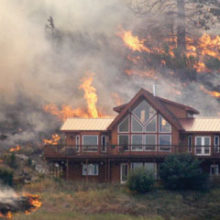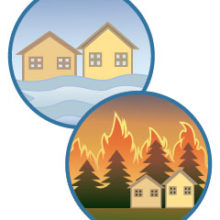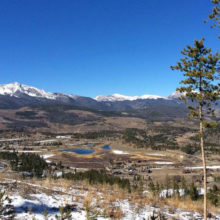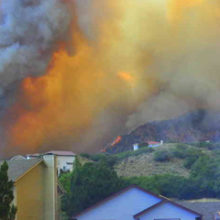Solutions for Controlling the Pace, Scale, and Pattern of Future Development in the Wildland-Urban Interface
- Wildfires increasingly are expensive and dangerous, burning homes, and consuming agency budgets. Defending private homes next to federal lands drives a large portion of these costs and risks.
- Attempts to mitigate wildfire risk–such as voluntary landowner education and fuels reduction–while important, alone are insufficient for the magnitude of the growing wildfire problem, which is exacerbated by a warming climate and continued home building.
- This report outlines new ideas that could significantly reduce costs and risks by making future home building on fire-prone lands safer. Getting the incentives right is essential; with negative consequences for decisions that increase risk, and positive rewards for decisions that reduce risk.
- A portion of this report was published in the March 2015 issue of Solutions journal (Volume 6, Issue 2, Page 55-62).
Wildfires increasingly are expensive and dangerous, burning homes, and consuming agency budgets. A large portion of the costs and risks are related to the need to defend private homes next to federal lands.
Attempts to mitigate wildfire risk–such as voluntary landowner education and fuels reduction–while important, alone are insufficient for the magnitude of the growing wildfire problem, which is exacerbated by a warming climate and continued home building.
To more fully address future wildfire risks, this post offers nine ideas for how best to alter the pace, scale, and pattern of future home development. Getting the incentives right is essential. There should be negative financial consequences for private land management decisions that increase risk, and positive financial rewards for decisions that reduce risk. An accompanying white paper provides additional detail. A portion of this paper was also published in the March 2015 issue of The Solutions Journal.
The Problem
Long-term trends indicate the costs and dangers associated with defending homes in the Wildland-Urban Interface will continue to increase. In the West, 84 percent of the WUI is not yet developed, the housing market has picked up once more, and with climate change as an accelerator, costs and risks will only increase in the future.
In addition, communities are not controlling future development on fire-prone lands because the bulk of the firefighting costs are paid for by federal taxpayers and not at the local level (county and community), where the land use decisions are made. Meanwhile, communities either financially benefit—or perceive to benefit—from tax revenues from new residential developments.
The Trends


The Approach
It will be difficult to control the rising costs, damages, and dangers related to home development in the WUI unless there are negative financial consequences for private land management decisions that increase risk, and positive financial rewards for decisions that reduce risk.
Changing where homes are developed in the future can reduce dangers, damages, and costs, including the amount of money agencies spend to defend homes from wildfire.
Nine Solutions
Below are nine ideas aimed at affecting the pace, scale, and pattern of future home building in the not-yet-developed portion of the WUI. They are divided into three categories based on who has the authority to act.
Local Solutions
Local solutions can be acted on by city and county government. They are:
(1) improved integration of wildfire mitigation plans into county comprehensive land use plans and; and
(2) mandatory disclosure of fire risk to potential homebuyers.
Administrative Solutions
Administrative solutions, which can be acted on by federal land managers, include:
(3) bill state and local governments for their share of firefighting costs to create a powerful incentive for improved local land use planning;
(4) shift more fire suppression responsibility to local governments;
(5) provide technical and financial assistance for land use planning to local governments, prioritized according to local actions to reduce fire risk;
(6) buy land or development rights on the most dangerous areas;
(7) improve firefighter safety through improved public education and active participation in county land use planning; and
(8) map of fire risk using national standards, with incentives for added detail by local governments.
Legislative Solutions
Legislative solutions would require action by Congress.
(9) We outline a number of principles that would be essential to incorporate into legislation aimed at reducing the costs and risks associated with home building on fire-prone lands.
The ideas are presented as a starting point for a national dialogue on wildfire and reducing risks and costs to communities through improved land use planning. We welcome comments and additional ideas.
Media
Read a September 2016 Op-Ed carried by the Los Angeles Times on the need to have better incentives to reduce wildfire risks and costs; or listen to an interview with our Executive Director, Ray Rasker, on Montana Public Radio (“The Cost of Development in Wildfire Country” October 2, 2014):




